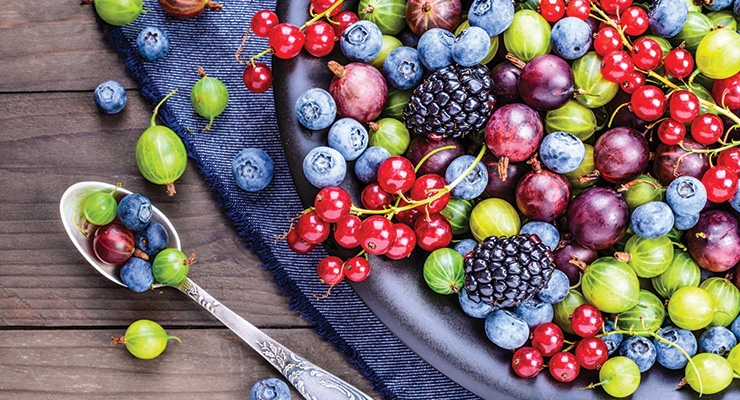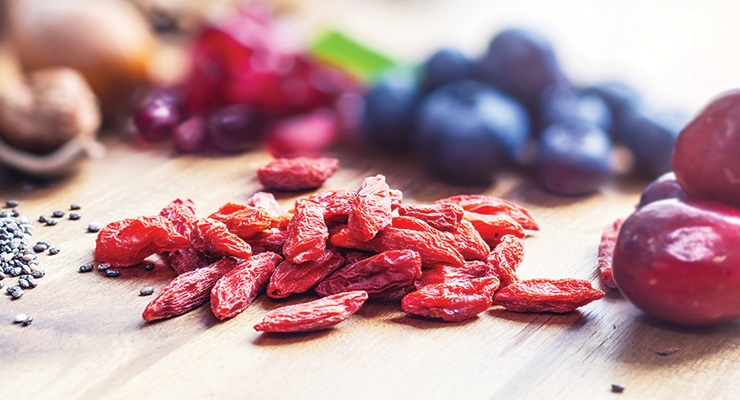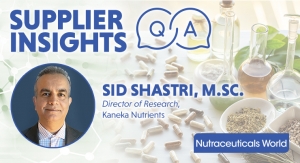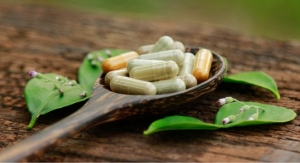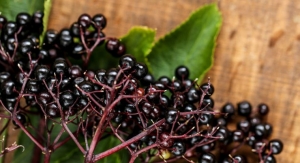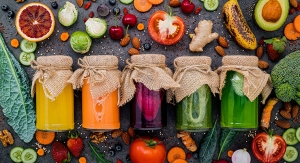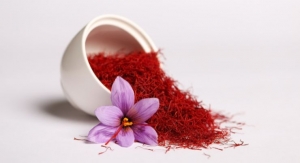By Lisa Olivo, Associate Editor03.01.18
Nutritionally depleted diets, exposure to pollutants and chemicals, and the stresses of modern living can negatively impact human health, and are contributing factors to the generation of free radicals in the body. These unstable molecules cause damage within cells and tissues, and contribute to oxidative stress. Consuming foods rich in antioxidants can help combat this degradation, however, modern diets are often woefully insufficient when it comes to supplying the vital nutrients needed for optimal health.
Dietary supplements, functional foods, and nutritional beverages fortified with antioxidants offer effective and convenient support for consumers looking to protect their health from a diverse assortment of health concerns.
Globally, the antioxidant market earned $2.92 billion in 2015, according to Allied Market Research, and is expected to grow at a CAGR of 6.4% looking ahead to 2022, potentially earning $4.53 billion.
“Alcohol, pollution, petrochemicals, pesticides, stress, unhealthy diets, excessive calories, sedentary lifestyle, use of drugs to temporarily minimize symptoms of chronic health ailments, etc., are all contributing factors in the generation of free radicals such as reactive oxygen species (ROS),” explained Tryggvi Stefánsson, PhD, science manager for Reykjanesbaer, Iceland-based Algalif. It is estimated that each cell in the body forms more than 20 trillion ROS per day through normal metabolism, and each cell in the body is believed to be attacked by these reactive molecules 10,000 times per day, damaging cellular structures, lipids, proteins, and genetic material (DNA), he added. Dietary intake of antioxidants can delay or impede cellular damage by scavenging free radicals.
“Several decades of dietary research findings suggest that consuming greater amounts of antioxidant-rich foods might help people to stay healthy,” noted Dr. Stefánsson. “Because of these results, there has been a lot of interest in antioxidant supplements. Dietary supplementation with antioxidants is receiving growing attention and is increasingly being adopted in western countries.”
General Wellness
Because antioxidants offer support across a wide range of health issues for various demographics, consumers are beginning to see antioxidants as a “catch-all” for overall health and wellness.
Diane Ray, vicepresident strategic innovation for the Natural Marketing Institute (NMI), Harleysville, PA, discussed recent consumer research indicating that while most people aren’t entirely sure why they need antioxidants in their diet, they’re willing to wager that antioxidants won’t hurt them, and will probably even help them (even if they don’t exactly understand how).
“People are recognizing that they need more antioxidants in their diets,” said Ms. Ray, pointing to NMI research that found approximately 16% of the general population believes they are deficient in antioxidants.
However, among those with a perceived deficiency, just 11% said they had actually taken an antioxidant supplement within the last 30 days.
Meanwhile, 38% of the general population said they wanted to get more antioxidants in their diet this past year. “This points to a much broader, kind of ‘multivitamin mindset,’ where consumers are thinking ‘I know antioxidants are good for me, I may or may not be able to say what they’re good for, but more is better and I should probably have more in my diet,’” observed Ms. Ray.
Marketers tend to go after this more vaguely interested group, compared to other subgroups of antioxidant consumers who may be more knowledgeable, or seek out antioxidants for a specific health concern, she said. “It’s a bigger group, and I would say they require less proof of actual results. They already have a belief that antioxidants are good—they’re keeping my cells from oxidizing, and therefore aging. Consumers often connect to the analogy that antioxidants keep my cells from ‘rusting’; it’s about healthy, energetic cells, and healthy cells that support general immunity. These are just a few of the variety of ways consumers believe antioxidants are beneficial for them.”
Others are seeking out foods or beverages fortified with antioxidants, or those naturally rich in nutrients like vitamins A, C, and E. Foods considered naturally rich in antioxidants included leafy greens, superfoods, or more fruits in general, she said.
Ms. Ray pointed to an opportunity for supplement formulators to add antioxidants to the mix, particularly for products targeting common nutritional deficiencies. For example, she said, “You may go to the doctor and find out you are deficient in vitamin B. Your doctor recommends you take a supplement. Now some brands are offering a B supplement, plus antioxidants. While the doctor didn’t necessarily say to take the antioxidants, most consumers see antioxidants on the label and see them as an added bonus. So maybe I’ll pay a little more, because I’m looking for the extra reassurance the additional antioxidants provide. Manufacturers are now offering this, and consumers are seeing this as a differentiator. If I go to the pharmacy and I see 15 different vitamin B supplements, the supplement with the added antioxidant support can help it stand out in the crowd.”
Of consumers who take antioxidant supplements, the largest percentage take them to support general health (60%); 20% say they take them to boost immunity; 18% report taking them for some kind of detoxification; about 16% are seeking anti-aging support; and about 15% think antioxidant supplements help with digestive health.
“This tells you that consumers aren’t exactly sure what antioxidants are for. Support for general health offers reassuring peace of mind,” said Ms. Ray. “For a lot of people, antioxidants are the next level up from a multivitamin. They take vitamins and minerals for general health assurance, and antioxidants can give them an extra boost.”
Aging Users
An aging global population is a key driver propelling awareness and sales in the antioxidant marketplace. “Reports show that older generations are primary drivers of growth for vitamin and supplement sales in general, and there is a particular focus on supplement benefits for healthy aging,” said Sébastien Bornet, vice president global sales & marketing at Switzerland-based Horphag Research, the exclusive worldwide supplier of Pycnogenol and Robuvit.
In 2014, Packaged Facts reported senior consumers controlled 70% of disposable income in the U.S., and to a large extent drove demand for nutraceuticals.
While interest in supplements is increasing among aging consumers, their numbers are growing. “Nearly all countries in the world are experiencing a growth in the number of seniors in the population, and this growth is projected to accelerate in the next decades,” said Dr. Stefánsson of Algalif. “According to data from the United Nations, one in eight people worldwide was aged 60 years or over in 2015, and by 2030, older persons are projected to account for one in six people globally. By 2050, one in every five people will be aged 60 years or over.”
For this older demographic, issues such as joint health and inflammation, memory and cognition, eyesight, cardiovascular health, and skin health are all top of mind, and there are a variety of antioxidant ingredients and formulas that can offer support.
For example, Scott Steinford, executive director of the CoQ10 Association and the Natural Algae Astaxanthin Association (NAXA), suggested much of the interest in CoQ10 and astaxanthin comes from aging supplement users.
Astaxanthin is gaining an awareness for its inflammation mitigation properties, which may help users support a healthy, active lifestyle with age, Mr. Steinford said. CoQ10, on the other hand, “continues to provide significant benefits for heart patients and the growing number of statin patients.” Furthermore, he noted, “both CoQ10 and astaxanthin contribute to energy production and provide anti-fatigue action for active adults.”
Meanwhile, lutein—a popular antioxidant long associated with the senior population—continues to expand into new categories supporting healthy aging. Brian Appell, marketing manager, OmniActive Health Technologies, Morristown, NJ, pointed to “compelling science supporting this powerful carotenoid’s health benefits for eye, skin, and brain health, which has implications across all age groups.”
“Although antioxidant supplementation can’t turn back the clock, it can help seniors to support their bodies’ antioxidant defense system,” commented Dr. Stefánsson. He predicted that interest for age-related antioxidant supplements would continue to grow as “aging populations with disposable incomes in both developed and emerging markets seek preventive strategies to live longer and healthier lives.” Moreover, Dr. Stefánsson suggested that as the retirement age gets pushed back further, older people will likely face increased demands for vitality in a highly competitive job market, leading them to seek support for stamina and overall health.
Sports Set
Strain on the body from intense exercise can lead to oxidative stress, causing damage to muscles and tissue. Antioxidant supplements have become increasingly popular with fitness enthusiasts and athletes, especially those pushing their bodies to the extreme in activities such as endurance training and weight lifting.
Golan Raz, PhD, head of the global health division for Orange, NJ-based Lycored, said people who are engaged in daily or weekly sport activities are one of the leading consumer groups taking antioxidant supplements in a variety of delivery formats, ranging from tablets and capsules, to gels, beverages, and more. “While healthy and balanced sport activities are a wonderful component of wellness, this group of people is exposed to both physical and environmental stress. One of the ways to balance this stress is by adding to the daily diet quality natural antioxidants from diversified sources.”
Resveratrol, a plant polyphenol, is a well-known natural antioxidant ingredient, noted Shaheen Majeed, president worldwide, Sabinsa, East Windsor, NJ, pointing to research supporting its benefits during exercise. A study published in the journal Applied Physiology, Nutrition, and Metabolism (Polley et al., 2016) found resveratrol was helpful in improving mitochondrial performance during low-intensity exercise training in healthy adults. Mr. Majeed explained, “In this double-blind, placebo-controlled clinical trial, four weeks of resveratrol (1,000 mg) supplementation along with BioPerine [Sabinsa’s patented black pepper extract supporting bioavailability] (20 mg) demonstrated a significant recovery of muscle oxidative capacity after a short bout of voluntary exercise when compared to placebo group.”
Research on astaxanthin has linked this antioxidant ingredient with benefits for muscle endurance and recovery. A 2015 study published in Evidence-Based Complementary and Alternative Medicine (Baralic et al.) included 40 male soccer players who were randomly assigned 4 mg of astaxanthin or a placebo, with saliva and blood samples collected at baseline and after 90 days of supplementation in pre-exercise conditions. Results showed that astaxanthin supplementation led to improved salivary IgA response with benefits for immunity, plus reduced muscle damage, thus preventing the inflammation induced by rigorous physical training.
A study published in 2013 in the Journal of Sports Medicine and Physical Fitness showed that Pycnogenol can also offer benefits for athletes. “Conducted in two parts with both recreational athletes and triathletes, participants were observed while completing sit-ups, push-ups, running, swimming, and biking over four and eight weeks,” explained Mr. Bornet. The clinical trial found that Pycnogenol, an antioxidant from French maritime pine tree bark, was effective in improving performance and endurance and reducing muscle cramping and soreness by controlling oxidative stress.
Additionally, curcumin is breaking into the sports nutrition category. “Curcumin delivers the sports nutrition benefits of turmeric, including a normal healthy inflammatory response after exercise,” noted Mr. Appell of OmniActive. “Recent research has shown that long-term supplementation with an enhanced bioavailable curcumin product can help support healthy blood flow and circulation as well as improve muscle performance, endurance capacity, and resistance to fatigue, which are important for sports performance and an active lifestyle.”
Eyes & Brain
New research suggests that exposure to high-energy blue light emitted from cell phones, computer screens, tablets, and televisions can lead to degradation of the eyes over time. In response, dietary supplement companies are seeking out ways in which antioxidants can help protect consumers from the damaging effects of digital lifestyles with the aid of macular carotenoids.
Mr. Appell discussed results of the B.L.U.E (Blue Light User Exposure) study, which found that lutein, RR-zeaxanthin, and RS (meso)-zeaxanthin from the company’s Lutemax 2020 ingredient had beneficial effects on visual health and performance by reducing eye strain and fatigue in those individuals with long-duration exposure to digital screens and other sources of high-energy blue light.
Further research of the antioxidant properties of the three macular carotenoids led researchers from the University of Georgia to find an interesting connection between increased levels of macular carotenoids in the eye, psychological stress, and serum cortisol. Discussing this new science, Mr. Appell explained, “Fifty-nine healthy, young adults aged 18 to 25 participated in the randomized, double-blind, placebo-controlled study in which blood cortisol, psychological stress ratings, behavioral measures of mood, and symptoms of sub-optimal health were measured at baseline, six months, and after 12-months of daily supplementation with either a placebo, 10/2 mg or 20/4 mg of lutein/zeaxanthin isomers from Lutemax 2020. The results showed that supplementation of both doses for six months significantly reduced serum cortisol and improved psychological stress and measures of emotional and physical health compared to placebo. Further improvement was seen after 12 months of supplementation.”
Lutein derived naturally in the diet also provides significant health benefits. Research found that consuming one fresh avocado per day may lead to improved cognitive function in healthy older adults due to increased lutein levels in the brain and eye. In the 2017 study published in the journal Nutrients, 40 healthy adults aged 50+ who ate one fresh avocado a day for six months experienced a 25% increase in lutein levels in their eyes and significantly improved working memory and problem-solving skills. While additional research is needed to determine whether the results could be replicated with consumption of the recommended serving size of 1/3 of an avocado per day (136 mcg lutein), the researchers reported gradual growth in the amount of lutein in their eyes and progressive improvement in cognition skills as measured by tests designed to evaluate memory, processing speed, and attention levels.
Fruit in Focus
Abundant antioxidant-rich fruits and berries, from the more commonplace to the obscure, have made their way into product formulations to offer antioxidant support.
NMI’s Ms. Ray said that while some people go out of their way to buy antioxidant-fortified foods or beverages, more consumers are looking for products that are “naturally healthy.” She speculated, “whole, fresh food, buy local, and the popularity of superfoods is driven by the desire for food that naturally supports nutrition. Underpinning this is really interesting, new science.”
Nutritional science, she said, is still at “just the tip of the iceberg” with new discoveries about how antioxidant compounds affect human health still in process. “How do antioxidants work when combined with other ingredients? What about when they’re cooked, or baked, or raw? Discoveries are still coming fast and furious. The science is just now beginning to scrape the surface.”
Ms. Ray also pointed to the resurgence of foods utilizing fruit ingredients such as pomegranates, blueberries, açaí, and cranberry as prime examples of naturally healthy antioxidant ingredients generating consumer interest. “Foods no one touched 20 years ago are now prevalent. When science shows the food you know is good for you is actually working, people feel good about that.”
Market data from Innova Market Insights found that these “superfruits” were growing as top antioxidant ingredients. Inclusion of açaí in finished products was up 21.8% in 2016 compared to 2012; pomegranate use increased 11.8%; and goji berry climbed to 10.1%.
Sea buckthorn berry is an ingredient that while once unfamiliar to consumers, is moving to the forefront of the antioxidant market. Ramon Luna, marketing coordinator for Ecuadorian Rainforest, Belleville, NJ, observed that sea buckthorn berry made “quite an impression in 2017,” and predicted the trend would continue. “Sea Buckthorn’s nutritional profile and exotic nature may be the reason why it has done so well,” he said. “Formulators understand that sea buckthorn can be applied to nearly any type of product, but also it can be used as a natural colorant and flavor. Consumers, now as savvy as ever due to their ability to web search any information, are aware that seeing sea buckthorn berry on a product may mean a good source of vitamin C, minerals, and amino acids.”
Mr. Luna believes more consumers continue to seek out exotic and novel antioxidant ingredients. Chokeberry, he said, is an ingredient to watch. “According to Market Insights Reports, chokeberry is poised to have significant growth up to 2022, especially in the U.S. and China.”
Berries as a class have been established as “potent antioxidant powerhouses,” according to Leslie Gallo, vice president of operations, Artemis International, Ft. Wayne, IN, because they have stood the test of time, leading to specialized and more substantiated berry ingredients and blends. For example, she said, the company’s line of products known as Berryceuticals consists of standardized berry extracts that deliver consistent levels of the anthocyanin color pigments—the flavonoid compounds largely influencing the high antioxidant potential of berries. “Knowledgeable consumers are increasingly interested in ensuring they are getting the purity, potency, and efficacy in the antioxidant supplements they take. Berries are not only safe and familiar, but quality berry ingredients can confidently offer the antioxidant and related health benefits consumers seek.“
Cranberries have long been used to support urinary tract health, and nutritional ingredients harnessing their antioxidant potency have seen market success. Cran-Max, a concentrated cranberry-based ingredient, has been used in a variety of urinary tract infection (UTI) support supplements, noted Tim Bauer, vice president of sales, Pharmachem, a division of Ashland, Kearny, NJ. The nutritional ingredient has six clinical studies to its credit showing its ability to change the bacterial structure and prevent adhesion to the walls of the bladder or urinary tract, explained Mr. Bauer. “A peer-reviewed study published in the Journal of Antimicrobial Chemotherapy compared the effects of a commonly prescribed antibiotic to Cran-Max in women with reoccurring UTIs and found that Cran-Max was comparable to an antibiotic for UTI prevention. The study showed that taking one 500-mg dose of Cran-Max starts working immediately on UTIs, in contrast to other cranberry supplements that need to be taken for longer periods of time before seeing a response.”
Developing Research
Some of the most interesting research emerging in the antioxidant market is based on how these nutritional compounds can influence genetic pathways that can have profound and systemic influences on health, said Mr. Appell. For example, OmniActive has done extensive preclinical work—including nutrigenomic, in vitro, and in vivo research—on its bioavailable CurcuWIN curcumin formula. “It’s shown to have a significant impact on several key markers of health, one of which is cardiovascular health,” noted Mr. Appell. “We are using this preclinical work to guide our research and we’re seeing some significant benefits from it. Using the results we found from the preclinical work on CurcuWIN and its influence on cardiovascular markers, we designed our FloMeD study to see how CurcuWIN impacts flow mediated dilation (FMD) a key indicator of cardiovascular health.” In this study, researchers uncovered that supplementation with CurcuWIN can potentially reduce the risk of cardiovascular disease by up to 50% in healthy individuals. “This is just one example of our clinical program that is looking at how nutrients and antioxidants influence health at a cellular level and using the results as a guidepost for our human clinical work. And we’re seeing clinically meaningful results in our research across our product lines.”
Evolving research on curcuminoids suggests these potent antioxidants can provide protection against lipid peroxidation, hydroxyl and superoxide radicals, and improve activities of enzymatic antioxidants, noted Sabinsa’s Mr. Majeed.
A recent study published in the journal Inflammopharmacology in 2017 demonstrated the significant antioxidant effects of curcumin, utilizing Sabinsa’s Curcumin C3 Complex, a patented natural turmeric root extract, standardized to 95% curcuminoids. “In a randomized, double-blind, placebo-controlled trial, three-month supplementation of Curcumin C3 Complex and BioPerine (the company’s standardized black pepper extract to enhance the bioavailability of C3 Complex) in 118 diabetic patients resulted in a significant increase in serum total antioxidant capacity and SOD activity (p<0.001, both), whereas serum MDA level was found to be significantly decreased (p<0.001) compared to placebo group,” explained Mr. Majeed.
Anne Trias, MS, product director at American River Nutrition, Hadley, MA, explained that while a variety of antioxidants are helpful in protecting the body’s cells, science around vitamin E is beginning to uncover how it is uniquely shaped to reside within the lipid cell membrane to protect its integrity. “Few are aware that vitamin E is a family of molecules that include tocopherols and tocotrienols,” she explained. “Of the two, tocotrienol is an emerging antioxidant ingredient. Aside from protecting cell membranes—tocotrienols were shown to be about 50-times more potent as an antioxidant compared to tocopherols [Free Radical Biology and Medicine, 1991])—tocotrienols also protect lipids such as omega-3s in softgel products and foods and beverages [Food Chemistry, 2015].”
NAXA’s Mr. Steinford said exciting exploratory research is uncovering astaxanthin’s potential benefits in the area of liver health. A 2017 study published in Pharmacognosy Research examined the hepatoprotective effects of astaxanthin in carbon tetrachloride (CCl4)-treated rats. In the study, administration of the CCl4 increased oxidative stress-mediated hepatic damage and inflammation in the rats. Astaxanthin was found to have a preventive effect on oxidative stress and inflammatory cells infiltration, and ameliorated the progression of hepatic fibrosis.
The Q-Symbio Study released in late 2014 continues to influence the medical community, Mr. Steinford added, as it “demonstrated a significant 43% decrease in cardiovascular death compared to the placebo group. He explained, “The Q-Symbio is the largest placebo-controlled study of CoQ10 for heart failure in the world to date. It is interesting to note the results of the Q-Symbio study on congestive heart failure were significantly better than the results of a CHF study supporting the introduction of the Novartis drug Entresto. Entresto prevented statistically fewer deaths than CoQ10 but Entresto is expected to be a $5 billion a year drug for Novartis and achieved $500 million in sales in 2017. Entresto costs approximately $4,000 per year, versus CoQ10 at under $400 per year.”
New research published in 2017 in MDPI’s journal Nutrients found that the polyphenols in Pycnogenol are directly distributed into joint synovial fluid to reduce C-reactive protein (CRP) levels and inhibit nuclear factor-kappa B to reduce inflammation at the source, Mr. Bornet said. Additionally, a recent 2017 study in Minerva Ginecologica demonstrated that Pycnogenol helps to alleviate the disruptive symptoms associated with menopause transition and to reduce cardiovascular disease risk markers, CRP, and homocysteine.
Safety & Efficacy
When discussing the ways in which testing can be used to prove the efficacy, potency, and purity of antioxidant ingredients, Lycored’s Dr. Raz observed “a growing number of brands committed to preclinical scientific investments.” The reason behind this push for scientific backing, “is that using advanced preclinical methods is a safe and effective way to demonstrate safety, synergy, and efficacy of new antioxidants.”
Samantha Ford, new business development director, AIDP, City of Industry, CA, noted that the technology for testing antioxidants has become more sophisticated in recent years. “We’ve been able to develop more precise tools and methods of analysis that allow us to learn more about these beneficial ingredients than ever before. For example, botanical extracts may contain multiple active compounds. Whereas in the past these may have been difficult to separate and differentiate, we can now identify and even standardize for these multiple actives. What’s more, we can isolate and test each of these actives to further study and better understand their individual modes of action.”
Sabinsa’s Mr. Majeed pointed to the rise of various new techniques and analytical tools, such as “spectroscopy (e.g., ORAC, DPPH, ABTS, FRAP), electro-chemical methods (e.g., voltammetry, amperometry), and chromatography techniques (e.g., gas chromatography, high-performance liquid chromatography), which have been developed to determine the antioxidant profile of various ingredients.”
However, he cautioned that each assay may not be able to identify all types of antioxidants. “There is debate going on in the industry and scientific community regarding their validity when it comes to ‘translating’ the observed in vitro activity into ‘biological effect.’ Moving ahead, both the industry as well as researchers should work together to develop valid, reliable testing methods which enable proof of antioxidant potential, from cell-based assays to biological effects.”
Antioxidant Forecast
As the global antioxidant market continues to expand looking ahead, sales in the Asia-Pacific region are expected to propel growth. “The global natural antioxidants market is expected to reach $4.14 billion by 2022 [Grand View Research],” said Gilbia Portela, marketing manager for Algalif. “Demand for natural antioxidants was highest in Asia-Pacific in 2014, closely followed by North America. Asia-Pacific is expected to witness the fastest growth in the global market due to the presence of robust manufacturing bases for foods and beverages in the region and the rising awareness among consumers regarding the benefits of naturally sourced products.”
Additionally, she said combining natural antioxidant ingredients that may provide synergistic or additive effects for neutralizing free radicals would be an up-and-coming area of innovation. “This is a relatively new and evolving research field, even though the idea of an antioxidant network was proposed some years ago [Sies, Stahl, Sevanian, the Journal of Nutrition, 2005],” she said. “Scientists suggested a hypothesis that the components of the antioxidant network work as a team and different antioxidants also work in different parts of the cell depending on whether they are water- or lipid-soluble.”
For example, Ms. Portela said water-soluble vitamin C and glutathione protect the cell nucleus. Astaxanthin, on the other hand is lipid-soluble, giving it a “special affinity” for cell membranes. “Vitamin C and glutathione turn into weak free radicals after disarming free radicals. Astaxanthin can recycle them back into their active antioxidant form. This rescue and revive cycle prolongs the lifespan of these antioxidants and provides additive support for neutralizing free radicals. Notably, astaxanthin does not become oxidized by free radicals.”
Elyse Lovett, marketing manager for Kyowa Hakko U.S.A., Inc., New York, NY, predicted antioxidants targeting gastrointestinal health and whole-body detoxification would be strong trends in the year ahead. Glutathione is a key antioxidant ingredient supporting detoxification, she noted. “Glutathione supports the function of your liver, kidneys, GI tract, and intestines—your body’s major detoxification pathways. Glutathione helps in two main ways: it helps eliminate toxins, ingested chemicals, and potential carcinogens that the body has already absorbed; and it intercepts and neutralizes toxins in the GI tract before they are even absorbed.” Detoxification benefits may appeal to millennials who are seeking support for overall health, as well as baby boomers looking for protection from age-related conditions, she added.
Packaged Facts’ Food Forecast 2018 suggested a top food trend would be the use of vibrant color, rather than added sugar, in foods. Antioxidant-rich foods are often go-to ingredients for food manufacturers and chefs looking to make a visual impact while using safe and functional ingredients. Packaged Facts cited matcha, turmeric, beet, and purple cauliflower as high-antioxidant botanicals being used to signify natural and healthy to consumers.
The reasons consumers seek out antioxidants will continue to evolve as well. Innova Market Insights found that brain health was the fastest growing health position within the antioxidant category, with an average annual growth rate of 48.6% from 2012-2016, followed by sports & recovery (46.5%), eye health (42.9%); energy/alertness (39.5%); and weight management (38.9%). These health concerns will likely be areas of focus for future product formulations as more consumer seek out antioxidant products to support their health and wellness objectives.
Dietary supplements, functional foods, and nutritional beverages fortified with antioxidants offer effective and convenient support for consumers looking to protect their health from a diverse assortment of health concerns.
Globally, the antioxidant market earned $2.92 billion in 2015, according to Allied Market Research, and is expected to grow at a CAGR of 6.4% looking ahead to 2022, potentially earning $4.53 billion.
“Alcohol, pollution, petrochemicals, pesticides, stress, unhealthy diets, excessive calories, sedentary lifestyle, use of drugs to temporarily minimize symptoms of chronic health ailments, etc., are all contributing factors in the generation of free radicals such as reactive oxygen species (ROS),” explained Tryggvi Stefánsson, PhD, science manager for Reykjanesbaer, Iceland-based Algalif. It is estimated that each cell in the body forms more than 20 trillion ROS per day through normal metabolism, and each cell in the body is believed to be attacked by these reactive molecules 10,000 times per day, damaging cellular structures, lipids, proteins, and genetic material (DNA), he added. Dietary intake of antioxidants can delay or impede cellular damage by scavenging free radicals.
“Several decades of dietary research findings suggest that consuming greater amounts of antioxidant-rich foods might help people to stay healthy,” noted Dr. Stefánsson. “Because of these results, there has been a lot of interest in antioxidant supplements. Dietary supplementation with antioxidants is receiving growing attention and is increasingly being adopted in western countries.”
General Wellness
Because antioxidants offer support across a wide range of health issues for various demographics, consumers are beginning to see antioxidants as a “catch-all” for overall health and wellness.
Diane Ray, vicepresident strategic innovation for the Natural Marketing Institute (NMI), Harleysville, PA, discussed recent consumer research indicating that while most people aren’t entirely sure why they need antioxidants in their diet, they’re willing to wager that antioxidants won’t hurt them, and will probably even help them (even if they don’t exactly understand how).
“People are recognizing that they need more antioxidants in their diets,” said Ms. Ray, pointing to NMI research that found approximately 16% of the general population believes they are deficient in antioxidants.
However, among those with a perceived deficiency, just 11% said they had actually taken an antioxidant supplement within the last 30 days.
Meanwhile, 38% of the general population said they wanted to get more antioxidants in their diet this past year. “This points to a much broader, kind of ‘multivitamin mindset,’ where consumers are thinking ‘I know antioxidants are good for me, I may or may not be able to say what they’re good for, but more is better and I should probably have more in my diet,’” observed Ms. Ray.
Marketers tend to go after this more vaguely interested group, compared to other subgroups of antioxidant consumers who may be more knowledgeable, or seek out antioxidants for a specific health concern, she said. “It’s a bigger group, and I would say they require less proof of actual results. They already have a belief that antioxidants are good—they’re keeping my cells from oxidizing, and therefore aging. Consumers often connect to the analogy that antioxidants keep my cells from ‘rusting’; it’s about healthy, energetic cells, and healthy cells that support general immunity. These are just a few of the variety of ways consumers believe antioxidants are beneficial for them.”
Others are seeking out foods or beverages fortified with antioxidants, or those naturally rich in nutrients like vitamins A, C, and E. Foods considered naturally rich in antioxidants included leafy greens, superfoods, or more fruits in general, she said.
Ms. Ray pointed to an opportunity for supplement formulators to add antioxidants to the mix, particularly for products targeting common nutritional deficiencies. For example, she said, “You may go to the doctor and find out you are deficient in vitamin B. Your doctor recommends you take a supplement. Now some brands are offering a B supplement, plus antioxidants. While the doctor didn’t necessarily say to take the antioxidants, most consumers see antioxidants on the label and see them as an added bonus. So maybe I’ll pay a little more, because I’m looking for the extra reassurance the additional antioxidants provide. Manufacturers are now offering this, and consumers are seeing this as a differentiator. If I go to the pharmacy and I see 15 different vitamin B supplements, the supplement with the added antioxidant support can help it stand out in the crowd.”
Of consumers who take antioxidant supplements, the largest percentage take them to support general health (60%); 20% say they take them to boost immunity; 18% report taking them for some kind of detoxification; about 16% are seeking anti-aging support; and about 15% think antioxidant supplements help with digestive health.
“This tells you that consumers aren’t exactly sure what antioxidants are for. Support for general health offers reassuring peace of mind,” said Ms. Ray. “For a lot of people, antioxidants are the next level up from a multivitamin. They take vitamins and minerals for general health assurance, and antioxidants can give them an extra boost.”
Aging Users
An aging global population is a key driver propelling awareness and sales in the antioxidant marketplace. “Reports show that older generations are primary drivers of growth for vitamin and supplement sales in general, and there is a particular focus on supplement benefits for healthy aging,” said Sébastien Bornet, vice president global sales & marketing at Switzerland-based Horphag Research, the exclusive worldwide supplier of Pycnogenol and Robuvit.
In 2014, Packaged Facts reported senior consumers controlled 70% of disposable income in the U.S., and to a large extent drove demand for nutraceuticals.
While interest in supplements is increasing among aging consumers, their numbers are growing. “Nearly all countries in the world are experiencing a growth in the number of seniors in the population, and this growth is projected to accelerate in the next decades,” said Dr. Stefánsson of Algalif. “According to data from the United Nations, one in eight people worldwide was aged 60 years or over in 2015, and by 2030, older persons are projected to account for one in six people globally. By 2050, one in every five people will be aged 60 years or over.”
For this older demographic, issues such as joint health and inflammation, memory and cognition, eyesight, cardiovascular health, and skin health are all top of mind, and there are a variety of antioxidant ingredients and formulas that can offer support.
For example, Scott Steinford, executive director of the CoQ10 Association and the Natural Algae Astaxanthin Association (NAXA), suggested much of the interest in CoQ10 and astaxanthin comes from aging supplement users.
Astaxanthin is gaining an awareness for its inflammation mitigation properties, which may help users support a healthy, active lifestyle with age, Mr. Steinford said. CoQ10, on the other hand, “continues to provide significant benefits for heart patients and the growing number of statin patients.” Furthermore, he noted, “both CoQ10 and astaxanthin contribute to energy production and provide anti-fatigue action for active adults.”
Meanwhile, lutein—a popular antioxidant long associated with the senior population—continues to expand into new categories supporting healthy aging. Brian Appell, marketing manager, OmniActive Health Technologies, Morristown, NJ, pointed to “compelling science supporting this powerful carotenoid’s health benefits for eye, skin, and brain health, which has implications across all age groups.”
“Although antioxidant supplementation can’t turn back the clock, it can help seniors to support their bodies’ antioxidant defense system,” commented Dr. Stefánsson. He predicted that interest for age-related antioxidant supplements would continue to grow as “aging populations with disposable incomes in both developed and emerging markets seek preventive strategies to live longer and healthier lives.” Moreover, Dr. Stefánsson suggested that as the retirement age gets pushed back further, older people will likely face increased demands for vitality in a highly competitive job market, leading them to seek support for stamina and overall health.
Sports Set
Strain on the body from intense exercise can lead to oxidative stress, causing damage to muscles and tissue. Antioxidant supplements have become increasingly popular with fitness enthusiasts and athletes, especially those pushing their bodies to the extreme in activities such as endurance training and weight lifting.
Golan Raz, PhD, head of the global health division for Orange, NJ-based Lycored, said people who are engaged in daily or weekly sport activities are one of the leading consumer groups taking antioxidant supplements in a variety of delivery formats, ranging from tablets and capsules, to gels, beverages, and more. “While healthy and balanced sport activities are a wonderful component of wellness, this group of people is exposed to both physical and environmental stress. One of the ways to balance this stress is by adding to the daily diet quality natural antioxidants from diversified sources.”
Resveratrol, a plant polyphenol, is a well-known natural antioxidant ingredient, noted Shaheen Majeed, president worldwide, Sabinsa, East Windsor, NJ, pointing to research supporting its benefits during exercise. A study published in the journal Applied Physiology, Nutrition, and Metabolism (Polley et al., 2016) found resveratrol was helpful in improving mitochondrial performance during low-intensity exercise training in healthy adults. Mr. Majeed explained, “In this double-blind, placebo-controlled clinical trial, four weeks of resveratrol (1,000 mg) supplementation along with BioPerine [Sabinsa’s patented black pepper extract supporting bioavailability] (20 mg) demonstrated a significant recovery of muscle oxidative capacity after a short bout of voluntary exercise when compared to placebo group.”
Research on astaxanthin has linked this antioxidant ingredient with benefits for muscle endurance and recovery. A 2015 study published in Evidence-Based Complementary and Alternative Medicine (Baralic et al.) included 40 male soccer players who were randomly assigned 4 mg of astaxanthin or a placebo, with saliva and blood samples collected at baseline and after 90 days of supplementation in pre-exercise conditions. Results showed that astaxanthin supplementation led to improved salivary IgA response with benefits for immunity, plus reduced muscle damage, thus preventing the inflammation induced by rigorous physical training.
A study published in 2013 in the Journal of Sports Medicine and Physical Fitness showed that Pycnogenol can also offer benefits for athletes. “Conducted in two parts with both recreational athletes and triathletes, participants were observed while completing sit-ups, push-ups, running, swimming, and biking over four and eight weeks,” explained Mr. Bornet. The clinical trial found that Pycnogenol, an antioxidant from French maritime pine tree bark, was effective in improving performance and endurance and reducing muscle cramping and soreness by controlling oxidative stress.
Additionally, curcumin is breaking into the sports nutrition category. “Curcumin delivers the sports nutrition benefits of turmeric, including a normal healthy inflammatory response after exercise,” noted Mr. Appell of OmniActive. “Recent research has shown that long-term supplementation with an enhanced bioavailable curcumin product can help support healthy blood flow and circulation as well as improve muscle performance, endurance capacity, and resistance to fatigue, which are important for sports performance and an active lifestyle.”
Eyes & Brain
New research suggests that exposure to high-energy blue light emitted from cell phones, computer screens, tablets, and televisions can lead to degradation of the eyes over time. In response, dietary supplement companies are seeking out ways in which antioxidants can help protect consumers from the damaging effects of digital lifestyles with the aid of macular carotenoids.
Mr. Appell discussed results of the B.L.U.E (Blue Light User Exposure) study, which found that lutein, RR-zeaxanthin, and RS (meso)-zeaxanthin from the company’s Lutemax 2020 ingredient had beneficial effects on visual health and performance by reducing eye strain and fatigue in those individuals with long-duration exposure to digital screens and other sources of high-energy blue light.
Further research of the antioxidant properties of the three macular carotenoids led researchers from the University of Georgia to find an interesting connection between increased levels of macular carotenoids in the eye, psychological stress, and serum cortisol. Discussing this new science, Mr. Appell explained, “Fifty-nine healthy, young adults aged 18 to 25 participated in the randomized, double-blind, placebo-controlled study in which blood cortisol, psychological stress ratings, behavioral measures of mood, and symptoms of sub-optimal health were measured at baseline, six months, and after 12-months of daily supplementation with either a placebo, 10/2 mg or 20/4 mg of lutein/zeaxanthin isomers from Lutemax 2020. The results showed that supplementation of both doses for six months significantly reduced serum cortisol and improved psychological stress and measures of emotional and physical health compared to placebo. Further improvement was seen after 12 months of supplementation.”
Lutein derived naturally in the diet also provides significant health benefits. Research found that consuming one fresh avocado per day may lead to improved cognitive function in healthy older adults due to increased lutein levels in the brain and eye. In the 2017 study published in the journal Nutrients, 40 healthy adults aged 50+ who ate one fresh avocado a day for six months experienced a 25% increase in lutein levels in their eyes and significantly improved working memory and problem-solving skills. While additional research is needed to determine whether the results could be replicated with consumption of the recommended serving size of 1/3 of an avocado per day (136 mcg lutein), the researchers reported gradual growth in the amount of lutein in their eyes and progressive improvement in cognition skills as measured by tests designed to evaluate memory, processing speed, and attention levels.
Fruit in Focus
Abundant antioxidant-rich fruits and berries, from the more commonplace to the obscure, have made their way into product formulations to offer antioxidant support.
NMI’s Ms. Ray said that while some people go out of their way to buy antioxidant-fortified foods or beverages, more consumers are looking for products that are “naturally healthy.” She speculated, “whole, fresh food, buy local, and the popularity of superfoods is driven by the desire for food that naturally supports nutrition. Underpinning this is really interesting, new science.”
Nutritional science, she said, is still at “just the tip of the iceberg” with new discoveries about how antioxidant compounds affect human health still in process. “How do antioxidants work when combined with other ingredients? What about when they’re cooked, or baked, or raw? Discoveries are still coming fast and furious. The science is just now beginning to scrape the surface.”
Ms. Ray also pointed to the resurgence of foods utilizing fruit ingredients such as pomegranates, blueberries, açaí, and cranberry as prime examples of naturally healthy antioxidant ingredients generating consumer interest. “Foods no one touched 20 years ago are now prevalent. When science shows the food you know is good for you is actually working, people feel good about that.”
Market data from Innova Market Insights found that these “superfruits” were growing as top antioxidant ingredients. Inclusion of açaí in finished products was up 21.8% in 2016 compared to 2012; pomegranate use increased 11.8%; and goji berry climbed to 10.1%.
Sea buckthorn berry is an ingredient that while once unfamiliar to consumers, is moving to the forefront of the antioxidant market. Ramon Luna, marketing coordinator for Ecuadorian Rainforest, Belleville, NJ, observed that sea buckthorn berry made “quite an impression in 2017,” and predicted the trend would continue. “Sea Buckthorn’s nutritional profile and exotic nature may be the reason why it has done so well,” he said. “Formulators understand that sea buckthorn can be applied to nearly any type of product, but also it can be used as a natural colorant and flavor. Consumers, now as savvy as ever due to their ability to web search any information, are aware that seeing sea buckthorn berry on a product may mean a good source of vitamin C, minerals, and amino acids.”
Mr. Luna believes more consumers continue to seek out exotic and novel antioxidant ingredients. Chokeberry, he said, is an ingredient to watch. “According to Market Insights Reports, chokeberry is poised to have significant growth up to 2022, especially in the U.S. and China.”
Berries as a class have been established as “potent antioxidant powerhouses,” according to Leslie Gallo, vice president of operations, Artemis International, Ft. Wayne, IN, because they have stood the test of time, leading to specialized and more substantiated berry ingredients and blends. For example, she said, the company’s line of products known as Berryceuticals consists of standardized berry extracts that deliver consistent levels of the anthocyanin color pigments—the flavonoid compounds largely influencing the high antioxidant potential of berries. “Knowledgeable consumers are increasingly interested in ensuring they are getting the purity, potency, and efficacy in the antioxidant supplements they take. Berries are not only safe and familiar, but quality berry ingredients can confidently offer the antioxidant and related health benefits consumers seek.“
Cranberries have long been used to support urinary tract health, and nutritional ingredients harnessing their antioxidant potency have seen market success. Cran-Max, a concentrated cranberry-based ingredient, has been used in a variety of urinary tract infection (UTI) support supplements, noted Tim Bauer, vice president of sales, Pharmachem, a division of Ashland, Kearny, NJ. The nutritional ingredient has six clinical studies to its credit showing its ability to change the bacterial structure and prevent adhesion to the walls of the bladder or urinary tract, explained Mr. Bauer. “A peer-reviewed study published in the Journal of Antimicrobial Chemotherapy compared the effects of a commonly prescribed antibiotic to Cran-Max in women with reoccurring UTIs and found that Cran-Max was comparable to an antibiotic for UTI prevention. The study showed that taking one 500-mg dose of Cran-Max starts working immediately on UTIs, in contrast to other cranberry supplements that need to be taken for longer periods of time before seeing a response.”
Developing Research
Some of the most interesting research emerging in the antioxidant market is based on how these nutritional compounds can influence genetic pathways that can have profound and systemic influences on health, said Mr. Appell. For example, OmniActive has done extensive preclinical work—including nutrigenomic, in vitro, and in vivo research—on its bioavailable CurcuWIN curcumin formula. “It’s shown to have a significant impact on several key markers of health, one of which is cardiovascular health,” noted Mr. Appell. “We are using this preclinical work to guide our research and we’re seeing some significant benefits from it. Using the results we found from the preclinical work on CurcuWIN and its influence on cardiovascular markers, we designed our FloMeD study to see how CurcuWIN impacts flow mediated dilation (FMD) a key indicator of cardiovascular health.” In this study, researchers uncovered that supplementation with CurcuWIN can potentially reduce the risk of cardiovascular disease by up to 50% in healthy individuals. “This is just one example of our clinical program that is looking at how nutrients and antioxidants influence health at a cellular level and using the results as a guidepost for our human clinical work. And we’re seeing clinically meaningful results in our research across our product lines.”
Evolving research on curcuminoids suggests these potent antioxidants can provide protection against lipid peroxidation, hydroxyl and superoxide radicals, and improve activities of enzymatic antioxidants, noted Sabinsa’s Mr. Majeed.
A recent study published in the journal Inflammopharmacology in 2017 demonstrated the significant antioxidant effects of curcumin, utilizing Sabinsa’s Curcumin C3 Complex, a patented natural turmeric root extract, standardized to 95% curcuminoids. “In a randomized, double-blind, placebo-controlled trial, three-month supplementation of Curcumin C3 Complex and BioPerine (the company’s standardized black pepper extract to enhance the bioavailability of C3 Complex) in 118 diabetic patients resulted in a significant increase in serum total antioxidant capacity and SOD activity (p<0.001, both), whereas serum MDA level was found to be significantly decreased (p<0.001) compared to placebo group,” explained Mr. Majeed.
Anne Trias, MS, product director at American River Nutrition, Hadley, MA, explained that while a variety of antioxidants are helpful in protecting the body’s cells, science around vitamin E is beginning to uncover how it is uniquely shaped to reside within the lipid cell membrane to protect its integrity. “Few are aware that vitamin E is a family of molecules that include tocopherols and tocotrienols,” she explained. “Of the two, tocotrienol is an emerging antioxidant ingredient. Aside from protecting cell membranes—tocotrienols were shown to be about 50-times more potent as an antioxidant compared to tocopherols [Free Radical Biology and Medicine, 1991])—tocotrienols also protect lipids such as omega-3s in softgel products and foods and beverages [Food Chemistry, 2015].”
NAXA’s Mr. Steinford said exciting exploratory research is uncovering astaxanthin’s potential benefits in the area of liver health. A 2017 study published in Pharmacognosy Research examined the hepatoprotective effects of astaxanthin in carbon tetrachloride (CCl4)-treated rats. In the study, administration of the CCl4 increased oxidative stress-mediated hepatic damage and inflammation in the rats. Astaxanthin was found to have a preventive effect on oxidative stress and inflammatory cells infiltration, and ameliorated the progression of hepatic fibrosis.
The Q-Symbio Study released in late 2014 continues to influence the medical community, Mr. Steinford added, as it “demonstrated a significant 43% decrease in cardiovascular death compared to the placebo group. He explained, “The Q-Symbio is the largest placebo-controlled study of CoQ10 for heart failure in the world to date. It is interesting to note the results of the Q-Symbio study on congestive heart failure were significantly better than the results of a CHF study supporting the introduction of the Novartis drug Entresto. Entresto prevented statistically fewer deaths than CoQ10 but Entresto is expected to be a $5 billion a year drug for Novartis and achieved $500 million in sales in 2017. Entresto costs approximately $4,000 per year, versus CoQ10 at under $400 per year.”
New research published in 2017 in MDPI’s journal Nutrients found that the polyphenols in Pycnogenol are directly distributed into joint synovial fluid to reduce C-reactive protein (CRP) levels and inhibit nuclear factor-kappa B to reduce inflammation at the source, Mr. Bornet said. Additionally, a recent 2017 study in Minerva Ginecologica demonstrated that Pycnogenol helps to alleviate the disruptive symptoms associated with menopause transition and to reduce cardiovascular disease risk markers, CRP, and homocysteine.
Safety & Efficacy
When discussing the ways in which testing can be used to prove the efficacy, potency, and purity of antioxidant ingredients, Lycored’s Dr. Raz observed “a growing number of brands committed to preclinical scientific investments.” The reason behind this push for scientific backing, “is that using advanced preclinical methods is a safe and effective way to demonstrate safety, synergy, and efficacy of new antioxidants.”
Samantha Ford, new business development director, AIDP, City of Industry, CA, noted that the technology for testing antioxidants has become more sophisticated in recent years. “We’ve been able to develop more precise tools and methods of analysis that allow us to learn more about these beneficial ingredients than ever before. For example, botanical extracts may contain multiple active compounds. Whereas in the past these may have been difficult to separate and differentiate, we can now identify and even standardize for these multiple actives. What’s more, we can isolate and test each of these actives to further study and better understand their individual modes of action.”
Sabinsa’s Mr. Majeed pointed to the rise of various new techniques and analytical tools, such as “spectroscopy (e.g., ORAC, DPPH, ABTS, FRAP), electro-chemical methods (e.g., voltammetry, amperometry), and chromatography techniques (e.g., gas chromatography, high-performance liquid chromatography), which have been developed to determine the antioxidant profile of various ingredients.”
However, he cautioned that each assay may not be able to identify all types of antioxidants. “There is debate going on in the industry and scientific community regarding their validity when it comes to ‘translating’ the observed in vitro activity into ‘biological effect.’ Moving ahead, both the industry as well as researchers should work together to develop valid, reliable testing methods which enable proof of antioxidant potential, from cell-based assays to biological effects.”
Antioxidant Forecast
As the global antioxidant market continues to expand looking ahead, sales in the Asia-Pacific region are expected to propel growth. “The global natural antioxidants market is expected to reach $4.14 billion by 2022 [Grand View Research],” said Gilbia Portela, marketing manager for Algalif. “Demand for natural antioxidants was highest in Asia-Pacific in 2014, closely followed by North America. Asia-Pacific is expected to witness the fastest growth in the global market due to the presence of robust manufacturing bases for foods and beverages in the region and the rising awareness among consumers regarding the benefits of naturally sourced products.”
Additionally, she said combining natural antioxidant ingredients that may provide synergistic or additive effects for neutralizing free radicals would be an up-and-coming area of innovation. “This is a relatively new and evolving research field, even though the idea of an antioxidant network was proposed some years ago [Sies, Stahl, Sevanian, the Journal of Nutrition, 2005],” she said. “Scientists suggested a hypothesis that the components of the antioxidant network work as a team and different antioxidants also work in different parts of the cell depending on whether they are water- or lipid-soluble.”
For example, Ms. Portela said water-soluble vitamin C and glutathione protect the cell nucleus. Astaxanthin, on the other hand is lipid-soluble, giving it a “special affinity” for cell membranes. “Vitamin C and glutathione turn into weak free radicals after disarming free radicals. Astaxanthin can recycle them back into their active antioxidant form. This rescue and revive cycle prolongs the lifespan of these antioxidants and provides additive support for neutralizing free radicals. Notably, astaxanthin does not become oxidized by free radicals.”
Elyse Lovett, marketing manager for Kyowa Hakko U.S.A., Inc., New York, NY, predicted antioxidants targeting gastrointestinal health and whole-body detoxification would be strong trends in the year ahead. Glutathione is a key antioxidant ingredient supporting detoxification, she noted. “Glutathione supports the function of your liver, kidneys, GI tract, and intestines—your body’s major detoxification pathways. Glutathione helps in two main ways: it helps eliminate toxins, ingested chemicals, and potential carcinogens that the body has already absorbed; and it intercepts and neutralizes toxins in the GI tract before they are even absorbed.” Detoxification benefits may appeal to millennials who are seeking support for overall health, as well as baby boomers looking for protection from age-related conditions, she added.
Packaged Facts’ Food Forecast 2018 suggested a top food trend would be the use of vibrant color, rather than added sugar, in foods. Antioxidant-rich foods are often go-to ingredients for food manufacturers and chefs looking to make a visual impact while using safe and functional ingredients. Packaged Facts cited matcha, turmeric, beet, and purple cauliflower as high-antioxidant botanicals being used to signify natural and healthy to consumers.
The reasons consumers seek out antioxidants will continue to evolve as well. Innova Market Insights found that brain health was the fastest growing health position within the antioxidant category, with an average annual growth rate of 48.6% from 2012-2016, followed by sports & recovery (46.5%), eye health (42.9%); energy/alertness (39.5%); and weight management (38.9%). These health concerns will likely be areas of focus for future product formulations as more consumer seek out antioxidant products to support their health and wellness objectives.

